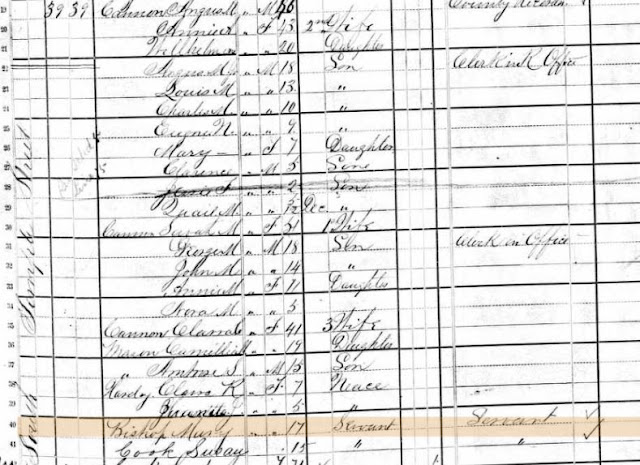Article 1, section 2 of the
Constitution calls for an “enumeration” to be made of the populace. The purpose of the enumeration or census was
to calculate how many representatives from a state were allowed in the House of
Representatives.
“Representatives and direct Taxes shall be
apportioned among the several States which may be included within this Union,
according to their respective Numbers, which shall be determined by adding to
the whole Number of free Persons, including those bound to Service for a Term
of Years, and excluding Indians not taxed, three fifths of all other Persons.
The actual Enumeration shall be made within three Years after the first Meeting
of the Congress of the United States, and within every subsequent Term of ten
Years, in such Manner as they shall by Law direct. The Number of
Representatives shall not exceed one for every thirty Thousand, but each State
shall have at Least one Representative; and until such enumeration shall be
made, the State of New Hampshire shall be entitled to chuse three,
Massachusetts eight, Rhode-Island and Providence Plantations one, Connecticut
five, New-York six, New Jersey four, Pennsylvania eight, Delaware one, Maryland
six, Virginia ten, North Carolina five, South Carolina five, and Georgia three.
When vacancies happen in the Representation from any State, the Executive
Authority”
The 1790 census simply recorded the name of head of
household and the number of people in that household and the county they were
in. It asked for very little information
beyond that. The 1850 census was the first to record the
names of all the people in the household, plus their age, occupation, and state
or country they were born in. The census
was moving away from simply recording how many people were in a state. In 1870 the questions asked were; Names,Age,Sex,Color,Profession,Value of Real Estate, Value of
Personal Estate, Place of Birth (State, Territory, Country), Father's
Birthplace, Mother's Birthplace, If born within the year, state month, If
married within the year, state month, Attended School within the Year (Y/N), Cannot
Read (Y/N), Cannot Write (Y/N), Deaf & dumb, blind, insane, idiotic,
pauper, or convict. Finally in the 1880
census they asked for who was the head of the household and for each person in
that household record their relationship to the head of the household, as wife,
son, daughter, boarder, servant etc. Obviously unexplained relationships
existed that did not fit the normal relationships.
Portrait of Ira Eldredge with his three wives: Nancy Black Eldredge, Hannah Mariah Savage Eldredge, and Helvig Marie Andersen Eldredge.
People
of the opposite sex living together without benefit of marriage (unlawful
cohabitation, shack-ups) have been going
on forever. In 1880 there were still
legal reasons for not being married, mainly race based marriages or
miscegenation not recognized by the state and Mormons and their practice of
polygamy. The census taker however had to come up with a explanation to fill
out the form however. Happily they asked
who ever said they were head of household and accepted whatever they were
told.
Usually
the way it was recorded in the census was the man was the head of the
household, his son and daughter living at home were recorded as his son and
daughter. The woman he was living with
was recorded as a boarder, her sons and daughters were recorded as
boarders. If it was a white man living
with a black woman instead of boarder she was recorded as a servant. Obviously there are a lot of variations in
the description recorded.
In
the 1970s the census bureau developed the term POSSLQ standing for "person of
opposite sex sharing living quarters” .
It was used in the 1980 census.
as an update to this post let me mention the Mormons in the 1880 census which asked for the relationship of each person in the household to the head of the household.
Below is the census page of Angus Munn Cannon (1834-1915) which shows his three wives. they are listed as wives and shows who was first wife, 2nd wife etc.
as an update to this post let me mention the Mormons in the 1880 census which asked for the relationship of each person in the household to the head of the household.
Below is the census page of Angus Munn Cannon (1834-1915) which shows his three wives. they are listed as wives and shows who was first wife, 2nd wife etc.
He would add a couple more wives after the census and it will come as no surprise that he had over twenty children. Of interest is the 2nd wife Annie Amanda Mousley Cannon (1836-1905) and 1st wife Sarah Mariah Mousley Cannon (1828-1912) . They are sisters and they were both from Delaware (Centerville). They were daughters of Titus Mousley and Ann McNenmy Mousley. The mousley family would be part of a wagon train that arrived in Salt Lake City. Sarah and Annie would marry on the same day in 1858 to Angus. Angus, who was a civil engineer, was sent with his family to a new community called Dixie in Utah. Dixie would be named St George and you have to wonder if it was just a coincidence or did his two Delaware wives influence the naming of St George. The whole story of traveling west and their life is of much interest.




No comments:
Post a Comment